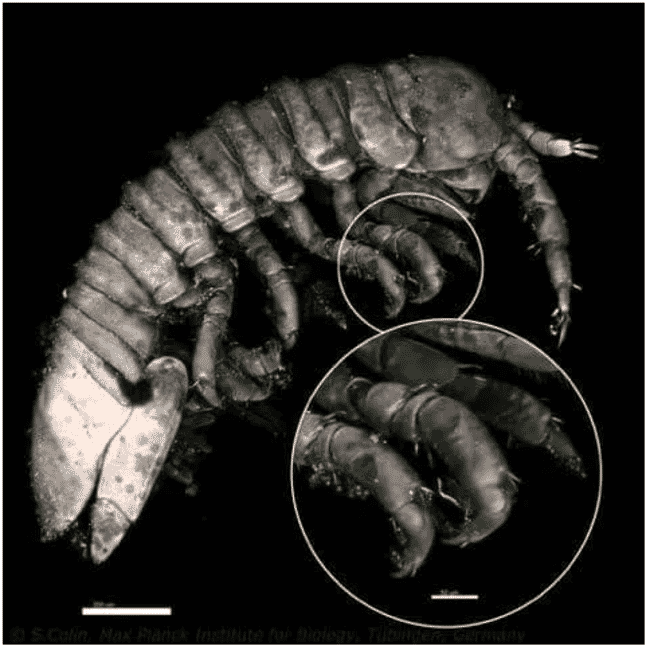
Young idotea viewed through confocal microscope. Spermatia (particles shown in green) are stuck to its cuticle. The close-up shows them clumped on the ends of its legs © Sébastien Colin
Though researchers have long understood the crucial role insects play in the pollination of flowering plants, algal fertilisation by marine animals was relatively unknown – and deemed non-existent. However, that conclusion is being re-evaluated after a team of researchers from the Roscoff Marine Station discovered that idoteas contribute to the reproductive cycle of the red algae Gracilaria gracilis. This observation goes against previous research that found that the dispersal of algal male gametes, or spermatia, depends on water movement instead of animal involvement. The scientists’ findings are published in the 29 July edition of Science and suggest that animal-mediated fertilisation is much older than once thought.
The international research team led by Myriam Valero, a CNRS scientist affiliated with the Evolutionary Biology and Ecology of Algae research unit (CNRS/Pontificia Universidad Católica de Chile/Sorbonne University/Universidad Austral de Chile) and Roscoff Marine Station (CNRS/Sorbonne University), has revealed that idoteas act as “sea bees” for Gracilaria gracilis – a seaweed that is used in IMTA projects and further processed for agar and carragheen.
Idoteas contribute to the fertilisation of G. gracilis as they swim amid these algae. The surfaces of the male algae are dotted with reproductive structures that produce spermatia coated with mucilage, a sticky substance. As an idotea passes by, the spermatia adhere to its cuticle and are then deposited on the thalli of any female alga the crustacean comes into contact, thus helping G. gracilis reproduction.
But idoteas also stand to benefit in this arrangement. The seaweed gives them room and board: idotea cling to the algae as a protection from strong currents, and they munch on small organisms growing on their thalli. This is an example of a mutualistic interaction—a win-win situation for plant and animal alike—and it is the first time that animal-mediated fertilisation of a seaweed has been observed.
While these initial findings do not indicate the extent to which animal transport of gametes contributes to algal fertilisation relative to the role of water movement they do offer surprising insight into the origin of animal-mediated fertilisation of plants.
Before this discovery, the latter was assumed to have emerged among terrestrial plants 140 million years ago. Red algae arose over 800 million years ago and their fertilisation via animal intermediaries may long predate the origin of pollination on land.
Valero’s team now aim to focus on several other questions: Do idoteas trigger the release of spermatia? Are they able to distinguish male G. gracilis algae from female individuals? And most importantly, do similar interactions exist between other marine species?




